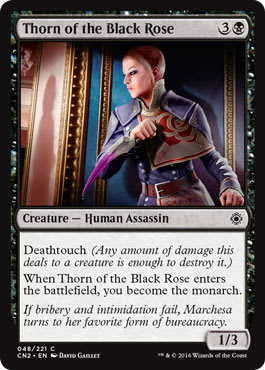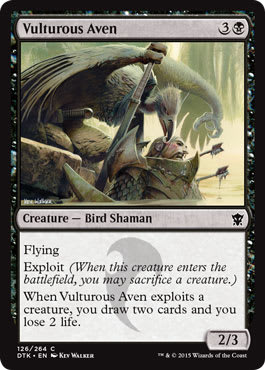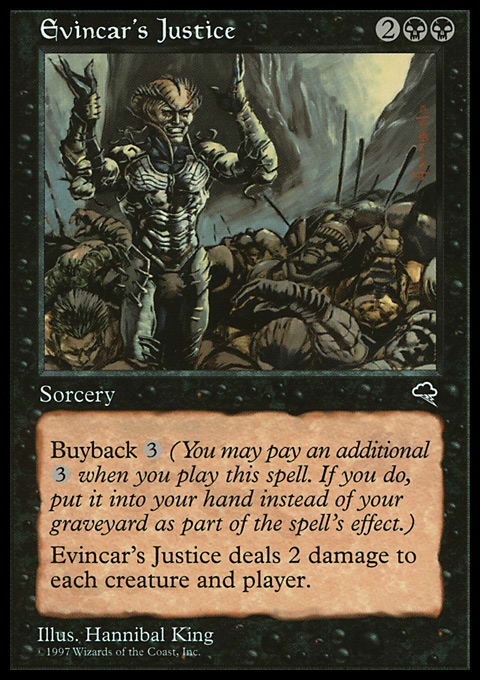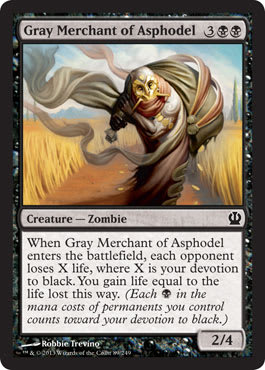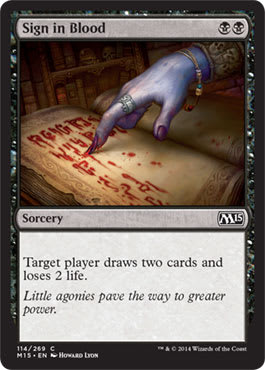The Pauper metagame is a cycle. Decks never really stop appearing, they just get less popular. Mono-Black Control has recently fallen on hard times in Pauper. The original best deck in the format is a shadow of its former self. Despite having the vast majority of decks relying on creatures, Black based control just could not keep up. For a long while it looked as if the deck was going to continue its downward trend since the removal spells available in Pauper are already near the height of the potential power level for common while every set adds new potential threats. Black looked to be locked behind the other decks as a solid option but far from the top tier. Of course then we got word that Thorn of the Black Rose from Conspiracy: Take the Crown would make its way to Magic Online, and suddenly Black’s prospects looked brighter. The ability to become the Monarch has proved powerful; and, in order to fully understand why it matters to Black we must first explore what the deck has been in the past.
Every iteration the deck called Mono-Black Control has been a midrange board control deck. It has always sought to use its removal and value creatures to bring the board state to parity. In the earliest days of Pauper this would be enough to facilitate victory as Mono-Black had access to some of the best game ending cards in Twisted Abomination and Corrupt. These earliest decks could only reach a point where it could cast these spells thanks to cards like Crypt Rats and Tendrils of Corruption. But then Goblins had to come along and changed the math on how removal worked.
Mono-Black Control adapted but took a step back. It instead became a deck that leaned heavily on Unearth and being able to get cheap second uses out of Chittering Rats and Phyrexian Rager. The Unearth builds of Mono-Black Control had to rely on finesse with removal in order to deal enough damage with undersized creatures. These builds were never as abundant as those based around Corrupt but they still put up reasonable numbers.
Mono-Black Control next burst on to the scene with Gray Merchant of Asphodel. Switching to a hard Devotion model, the deck adopted Cuombajj Witches and Oubliette as a way to dictate the field of battle while simultaneously adding Black mana pips for a massive Gray Merchant trigger. Vintage Masters added Chainer's Edict as a way to recoup card advantage and Fate Reforged gave the deck Gurmag Angler as an additional way to close out the game. Despite the presence of these powerful cards Mono-Black Control never really found a foothold after Treasure Cruise came and went. I talked about the history of Mono-Black Control in greater detail in this article from last year.
The issue that has plagued these decks for years is their inability to establish a dominant position from parity. Even the inclusion of cards like Pestilence, which could keep a board empty of threats, was hardly a sure thing. Do not get me wrong — Mono-Black could establish an unbeatable sequence of plays of Cuombajj Witches into Chittering Rats into multiple copies of Gray Merchant of Asphodel. But in the end it still had no one card that could pull you ahead in cards.
Compare this to a card like Mulldrifter. Mulldrifter is the standard when it comes to card advantage in Pauper. Against a Black deck, the flying fish represents three cards — the 2/2 flyer and the two cards that come along with the creature. The closest MBC could come to this is Phyrexian Rager. While Vulturous Aven exists, it simply was not a good enough card to see play. What would happen against other midrange decks is that the Black deck would expend its resources to establish an equal board state only to have it undone by a Mulldrifter or a Deep Analysis or something similar. All the removal in the world does not matter when your opponent is drawing more potential threats than you can draw answers.
Enter Thorn of the Black Rose. Thanks to the Monarch, it will automatically replace itself the same turn it enters the battlefield. As long as you avoid combat damage for the rest of the game you will get a free card every turn. Even if you lose the crown because of combat damage you can just attack back or play another Thorn of the Black Rose to reclaim the title of Monarch.
Being the Monarch changes the entire dynamic of a game. Now a secondary goal is to never take combat damage again as doing so will ensure a steady flow of cards. This is a benefit to decks like Mono-Black Control which thrive on one-for-one trades. While laying claim to the Monarch, a removal based Black deck can spend each removal spell on a new threat and then draw an additional card for free. And, unlike Mulldrifter, the Thorn can continue to draw cards beyond the first two. Suddenly, the deck has access to an avalanche of card advantage. It does not take long for one extra card per turn to simply bury an opponent.
Now this is all well and good, but before you can justify running a Black control deck there needs to be a good reason. The answer is Burning-Tree Emissary; or rather that is the threat. The presence of strong Burning-Tree Emissary draws puts an increased emphasis on needing to be able to take out multiple creatures in a single turn. Echoing Decay and Evincar's Justice both excel in this department and Crypt Rats is not far behind. In order to fully leverage these cards, running a heavy Swamp mana base is ideal. It also just so happens that both Cuombajj Witches and Thorn of the Black Rose have 3 toughness, making them ideal to live through a Justice.
This is the latest version of Mono-Black Control that I have been running. I ran something similar to a winning record in the league and have had success in the 2-person queues as well.
Mono-Black Control ? Pauper| Alex Ullman
- Creatures (19)
- 1 Crypt Rats
- 3 Gray Merchant of Asphodel
- 3 Thorn of the Black Rose
- 4 Cuombajj Witches
- 4 Liliana's Specter
- 4 Phyrexian Rager
- Instants (8)
- 1 Tendrils of Corruption
- 1 Tragic Slip
- 1 Unmake
- 2 Snuff Out
- 3 Echoing Decay
- Sorceries (6)
- 2 Evincar's Justice
- 4 Sign in Blood
- Enchantments (4)
- 1 Font of Return
- 3 Dead Weight
- Lands (23)
- 20 Swamp
- 3 Barren Moor
- Sideboard (15)
- 1 Crypt Rats
- 1 Gray Merchant of Asphodel
- 1 Grim Harvest
- 1 Tendrils of Corruption
- 1 Unmake
- 2 Gurmag Angler
- 2 Relic of Progenitus
- 3 Chainer's Edict
- 3 Duress
I want to start by talking about a few cards not in the maindeck — Chainer's Edict, Oubliette, and Chittering Rats. Chainer's Edict is in the sideboard because while it is a stellar card against certain decks it has lost some utility against the field. Kuldotha Tokens has Battle Screech and Stompy has Young Wolf. Spending two mana on your own turn to trade for part of a creature is not what Mono-Black Control wants to be doing. However it is good enough against both Hexproof and Izzet Blitz that it has a home in the sideboard. Oubliette, on the other hand, is slow when compared with every other option and has increased vulnerability to hate.
Chittering Rats used to be Mono-Black’s bellwether. When the Darksteel card was good, so too was the Mono-Black deck. Now Pauper is far more powerful. Not only are more decks running Mulldrifter but between Ash Barrens, Gush, and Thunderous Wrath there are multiple ways to mitigate the downside. Additionally there are plenty of decks adept at emptying their hand which makes a late game Chittering Rats less effective.
Removal
The core of a Black deck, the removal suite has to be tailored to the current format. Echoing Decay, Crypt Rats, and Evincar's Justice all exist to help keep decks that want to go wide from doing so. Dead Weight is less flexible than Disfigure but it has the upside of taking out a Kiln Fiend or Atog no questions asked. Tragic Slip is a hedge against early plays while not losing utility late. The two copies of Snuff Out are risky, but sometimes it is worth it to spend four life to save yourself from six damage. The main deck Unmake is a concession to Delver decks that bring Stormbound Geist out of the sideboard. You want access to multiple exile effects post board, and Unmake is serviceable enough in the main deck to warrant inclusion. Finally the lone Tendrils of Corruption is there to help keep you alive long enough to take control.
Creatures
Cuombajj Witches helps to keep smaller creatures in check while Phyrexian Rager keeps the cards flowing. Gray Merchant of Asphodel remains a solid game ending option that can also keep your life total high enough to effectively use Evincar's Justice and Crypt Rats. Thorn of the Black Rose is a reason to play Black these days. The Liliana's Specters may seem out of place since they have dis-synergy with the Witches. While true, the ability to take a card, not delay it, is important in the current metagame. It is also far better at taking back the title of Monarch than other options.
Card Draw
Sign in Blood remains the draw spell for Black decks. Two cards for 2 mana is hard to beat. Font of Return is not crad draw, per se, but in the late game it “draws” three creatures. The Font also adds to Devotion and can help win Monarch battles.
The Sideboard
Many of the inclusions are self explanatory. You want Tendrils and Gray Merchant against decks that aggressively pressure your life total while you want Duress against decks where a single card can beat you. Grim Harvest is for games you expect to go long while Crypt Rats is there as an additional board wipe. Relic of Progenitus is better here than other builds of Mono-Black Control due to the decreased reliance on the graveyard. Gurmag Angler used to be Okiba-Gang Shinobi for control matchups. What I found was that it was more important to maintain control of the Monarch against other control decks and Angler was a more robust threat that had an easier time connecting than Shinobi. Drawing so many cards made forcing your opponent to discard less vital.
Thorn of the Black Rose provides an effect powerful enough to revitalize a once great archetype. The creature provides a steady stream of cards that can create an insurmountable advantage. It is only a matter of time before it is a regular fixture on the Pauper scene.
















